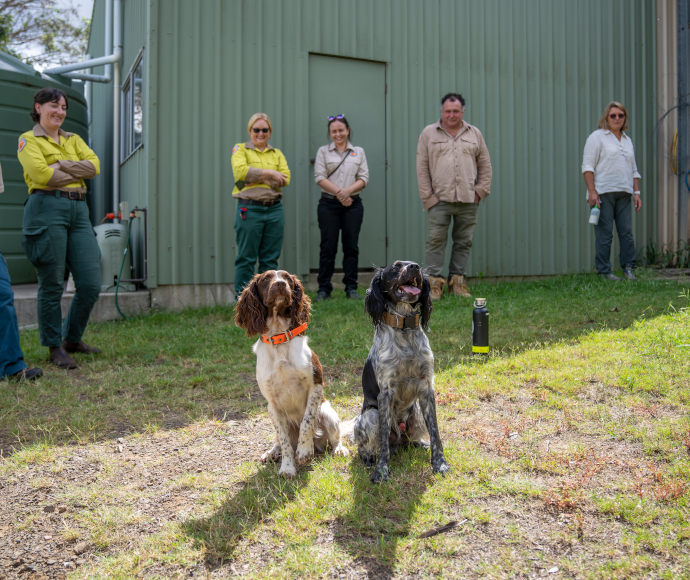Barrington Tops new ‘bark’ rangers: Alice and Echo sniff out silent killer threatening Australia's biodiversity
An unconventional yet effective team are helping to tackle Phytophthora dieback in Barrington Tops National Park.
In a ground-breaking initiative, conservation detection dogs Alice and Echo have been trained to sniff out Phytophthora cinnamomi, an unseen pathogen that is a major threat to Australia’s biodiversity, causing permanent damage to ecosystems with no feasible means to eradicate it once present.
These dogs are part of research by the NSW Government and partners to provide a rapid, low-cost tool for surveying high-risk pathways and limiting new infections. With an impeccable sense of smell, they can detect the presence of Phytophthora in concentrations as low as half a grain of rice in one kilo of soil.
During their recent visit to Barrington Tops Alice and Echo showed off their extensive skills, conducting trials to detect Phytophthora on vehicles, which could offer a quick means of preventing Phytophthora spread through the park, and at Polblue Swamp, the site of known Phytophthora cinnamomi infections.
This field testing was an important learning opportunity for Alice and Echo, and their trainers, to refine training techniques and strengthen the dogs' capability as reliable, on-site detection tools.
The discovery in the late 1990s of Phytophthora at an altitude of 1,500 metres in Barrington Tops, an area normally out of range of such threats, set off alarm bells for park managers and scientists. Barrington Tops is part of the Gondwana Rainforests of Australia World Heritage Area and is well-known for its incredible range of vegetation communities. Unfortunately, many of the species in this diverse ecosystem are susceptible to Phytophthora.
National Parks and Wildlife Service (NPWS) maintains a strict quarantine zone within Barrington Tops, where the majority of the infestation is concentrated. It is imperative that visitors do not enter this zone. Feral animals are also significant contributors to the spread of Phytophthora and NPWS has proactively addressed part of this concern through a longstanding feral pig control program.
This project is a collaboration between the NPWS, Tate Animal Training Enterprises, the University of Sydney, Botanic Gardens of Sydney’s PlantClinic and the NSW Department of Climate Change, Energy, the Environment and Water.
Quotes attributable to Julia Rayment, NPWS project lead:
'Alice and Echo are not your average dogs. These highly trained members of our conservation team have the potential to provide a rapid, accurate and inexpensive tool to prevent the spread of Phytophthora through our national parks.
'This trial in Barrington Tops is the most complex environment we’ve ever asked these detection dogs to work in. While there is still more training to be done, the field trials are a promising outcome for future success.
'The collaboration between Alice and Echo, NPWS park staff and our incredible partners guarantees to be a game-changer in the fight against this silent killer.
'Visitors to Barrington also have an important role to play to stop the spread. Do not enter the designated quarantine zone and make sure you “start clean, leave clean”. This means utilising boot hygiene stations where available or mixing up your own simple DIY solution of methylated spirits or bleach to disinfect your boots when entering or leaving a trail.'
